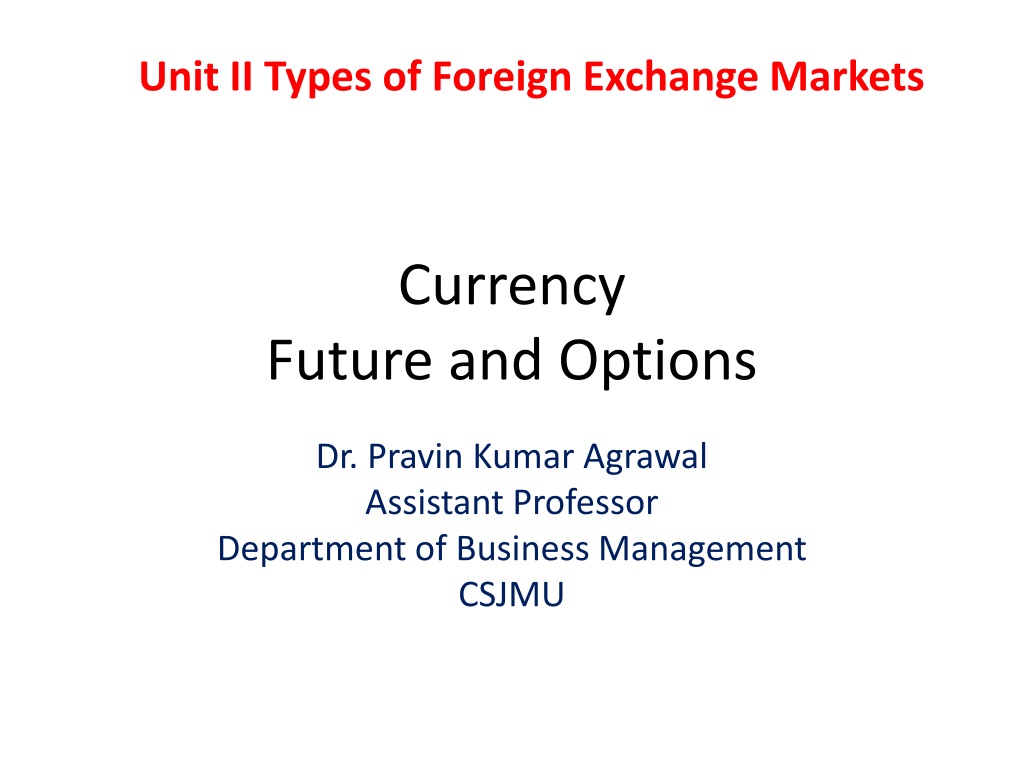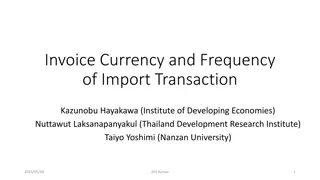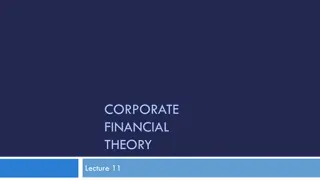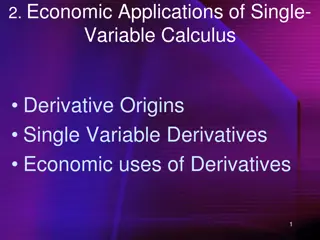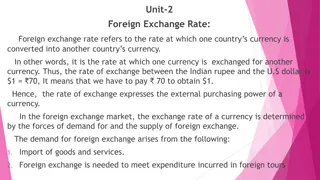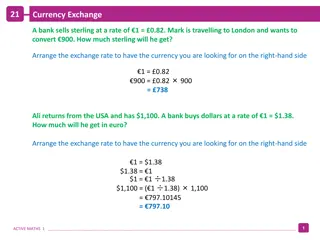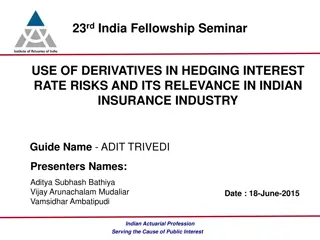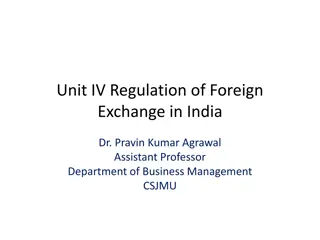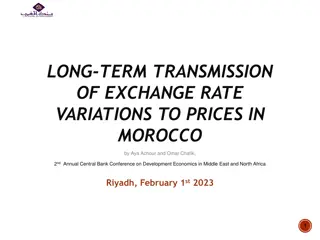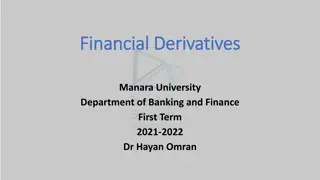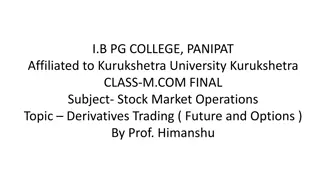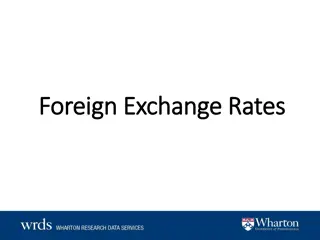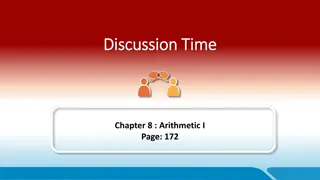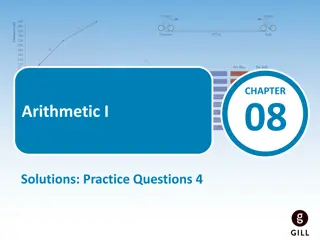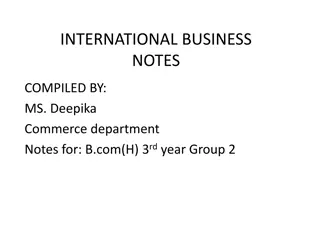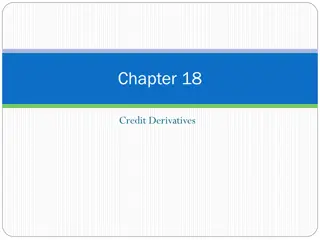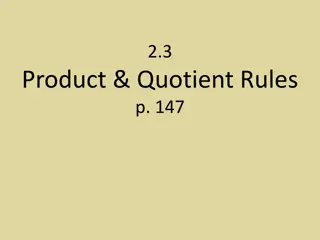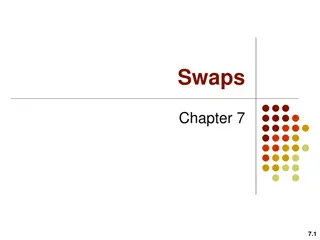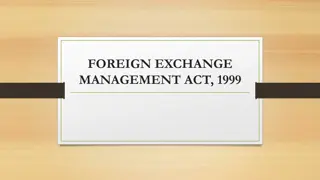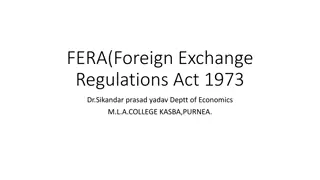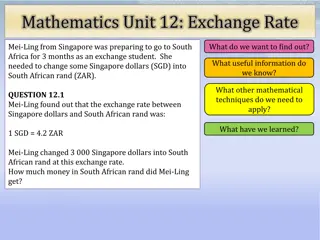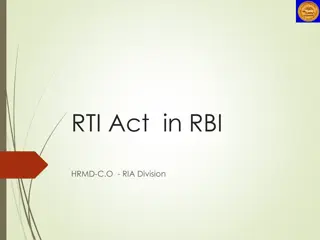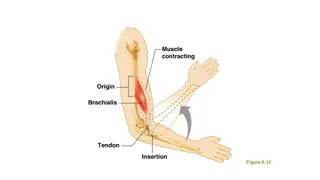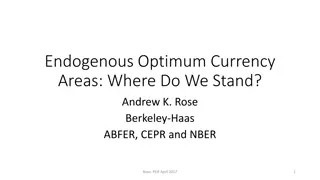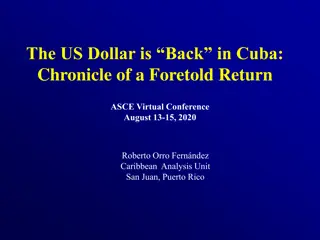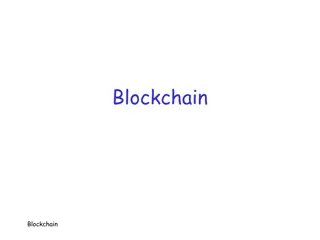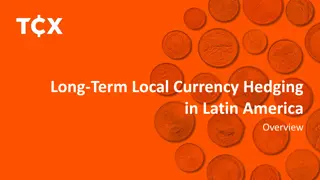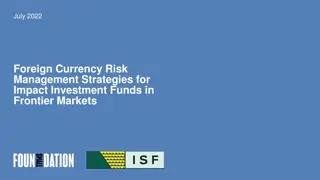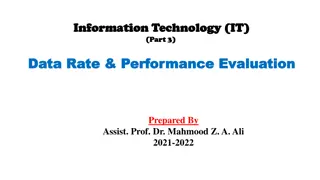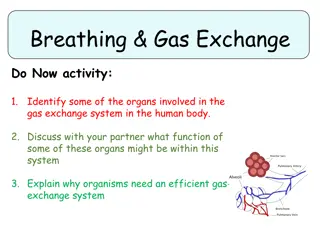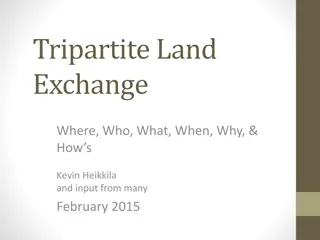Understanding Currency Derivatives and Exchange Rate Movements
Explore the history and significance of currency derivatives in global and Indian markets. Learn about currency appreciation, depreciation, and the impact on foreign exchange rates. Discover how to interpret changes in currency values and their implications for trading. Gain insights into the functioning of foreign exchange markets and the role of currency futures and options.
- Currency derivatives
- Exchange rate
- Foreign exchange markets
- Currency appreciation
- Currency depreciation
Download Presentation

Please find below an Image/Link to download the presentation.
The content on the website is provided AS IS for your information and personal use only. It may not be sold, licensed, or shared on other websites without obtaining consent from the author. Download presentation by click this link. If you encounter any issues during the download, it is possible that the publisher has removed the file from their server.
E N D
Presentation Transcript
Unit II Types of Foreign Exchange Markets Currency Future and Options Dr. Pravin Kumar Agrawal Assistant Professor Department of Business Management CSJMU
Currency Derivatives: A History Globally, Currency derivatives were first introduced on Chicago Mercantile Exchange (CME) in 1972 CME is the largest regulated FX market and offers 41 individual FX futures & 31 options contracts on 19 currencies
Currency Derivatives: A History In India, NSE introduced Currency Derivatives on August 29, 2008 with the launch of USDINR Currency Futures NSE launched trading in other currency pairs like Euro-INR, Pound Japanese Yen-INR in March 2010 Sterling-INR and
Currency Derivatives: A History NSE introduced Interest Rate futures trading in Aug 2009 on same platform while Currency Options was introduced in Oct 2010 NSE introduced Interest Rate futures trading in Aug 2009 on same platform while Currency Options was introduced in Oct 2010
Currency Derivatives: A History BSE launched Currency and Interest Rate Derivatives Trading on November 28, 2013 The total turnover on NSE in last ten years, increased from 1.6 Trillion in FY 2009 to 100 Trillion in FY 2020
Understanding Currency Appreciation & Depreciation
Appreciation & Depreciation Currency appreciation mean, increase in value of domestic currency against foreign currency. In other words it can buy more units of foreign currency than earlier. On the other side Currency depreciation mean, fall in the value of domestic currency against foreign currency and can buy less units of foreign currency than earlier.
Example If the price of USD/INR falls from 76 to 75, then INR would be said to have appreciated in value as you would now need less INR to buy the same number of USD. On other side, in same case USD would have depreciated as less INR would be remitted with same number of USD.
Options Basic terms As the word suggests, option means a choice or an alternative. To explain the concept though an example, take a case where you want to a buy a house and you finalize the house to be bought. On September 1st 2010, you pay a token amount or a security deposit of Rs 1,00,000 to the house seller to book the house at a price of Rs 10,00,000 and agree to pay the full amount in three months i.e., on November 30th The right to buy the asset is called call option and the right to sell the asset is called put option. 2010. After making full payment in three months, you get the ownership right of the house. During these three months, if you decide not to buy the house, because of any reasons, your initial token amount paid to the seller will be retained by him.
Options Basic terms In the above example, at the expiry of three months you have the option of buying or not buying the house and house seller is under obligation to sell it to you. In case during these three months the house prices drop, you may decide not to buy the house and lose the initial token amount. Similarly if the price of the house rises, you would certainly buy the house. Therefore by paying the initial token amount, you are getting a choice/ option to buy or not to buy the house after three months.
Options Basic terms The above arrangement between house buyer and house seller is called as option contract. We could define option contract as below:
Options Basic terms To make these terms more clear, let us refer to the earlier example of buying a house and answer few questions.
1. Does the above example constitute an option contract? If yes, 2. Is it a call option or put option? 3. What is the strike price? 4. What is the expiration date? 5. What is the time to maturity? 6. Who is the option buyer and who is the option seller? 7. What is the option premium? 8. What is the underlying asset?
Answer 1. Does the above example constitute an option contract? The above example constitutes an option contract as it has all the properties two parties, an underlying asset, a set price, and a date in future where parties will actually transact with right without obligation to one party. 2. Is it a call option or put option? It is a call option as you are paying the token amount to buy the right to buy the house 3. Who is the option buyer and who is the option sellers? You are the option buyer and house seller is option seller 4. What is the strike price? Rs 10,00,000 5. What is the expiration date? November 30th 2010 6. What is the time to maturity? Three months 7. What is the option premium? Rs 1,00,000 8. What is the underlying asset? The house is an underlying asset
Important Terms relating to Options
Basic Things To Know About Currency Options Option: It is a contract between two parties to buy or sell a given amount of asset at a pre- specified price on or before a given date. Like in the case of options on equities and indices, currency options are also a right (without an obligation) to buy or sell a currency pair. In terms of rupee currency pairs, there are options on USDINR, GBPINR, EURINR and JPYINR. Let us look at 5 basics of currency options.
Basic Things To Know About Currency Options The right to buy the currency pair is called call option and the right to sell the currency pair is called put option The pre-specified price is called as strike price and the date at which the strike price is applicable is called expiration date The gap between the date of entering into the contract and the expiration date (in number of days) is called time to maturity The price which option buyer pays to option seller to acquire the right is called as option price or option premium
Basic Things To Know About Currency Options The party which buys the rights but not obligation and pays premium for buying the right is called as option buyer and the party which sells the right and receives premium for assuming such obligation is called option seller/ writer The asset which is bought or sold is also called as an underlying or underlying asset and in case of currency options it is the currency pair
Basic Things To Know About Currency Options Buying an option is also called as taking a long position in an option contract and selling is also referred to as taking a short position in an option contract.
Options Currency option (also known as a forex option) is a contract that gives the buyer the right, but not the obligation, to buy or sell a certain currency at a specified exchange rate on or before a specified date. For this right, a premium is paid to the seller.
Call/Put Call options provide the holder the right (but not the obligation) to purchase currency pair at a specified price (the strike price), for a certain period of time. Buying a call option gives the holder the right to buy a currency pair for the strike price on or before the expiry date If the currency fails to meet the strike price before the expiration date, the option expires and becomes worthless. Investors buy calls when they think the share price of the underlying security will rise or sell a call if they think it will fall. Selling an option is also referred to as ''writing'' an option.
Put option It is the type of option that gives its holder a right to sell a currency at a pre-specified rate on or before the maturity date. buying a put option gives the holder the right to sell a currency pair for the strike price on or before the expiry date.
If the expiry arrives and the market price of a currency pair is above the strike price when buying calls, or below the strike price when buying puts, a trader can choose to exercise it.
But if this doesnt happen, a trader can let their option expire, and they ll only lose the value of the premium. As a result, buying call or put options means that a trader s upside is potentially unlimited, and their downside is capped at the premium.
Key take away No delivery of dollar happens only the difference is exchanged in rupees. If the dollar strengthens against rupee by or before expiry the call buyer makes money. If it weakens he loses. Similarly a put buyer makes money if the dollar weakens against the rupee, but loses if the dollar strengthens. The seller of call and put receives a premium from the buyer, which he pockets if the bet goes his way. Invariably, sellers make money while option buyers lose.
Premium It is the initial amount that the buyer (also called the option holder) of the option pays up-front to the seller (also called the option writer) of the option. By paying this premium, the holder acquires a right for himself and by receiving it, the writer takes an obligation upon himself to fulfill the right of the holder. Generally, it is a small percentage of the amount to be bought or sold under the option. We use notation, c, to denote premium on call option and notation, p, to denote premium on put option.
Exercise/Strike Price (Rate) It is the exchange rate at which the holder of a call option can buy and the holder of a put option can sell the currency under the deal, irrespective of the actual spot rate at the time of exercise of option. We use "X" to denote exercise price.
Maturity Date or Expiration Date The date on or up to which an option can be exercised. After this date, it becomes defunct and loses its validity.
American option When the option has the possibility of being exercised on any date up to maturity, it is called American type.
European option When an option has the possibility of being exercised only on the maturity date, it is called European type.
Value of an option An option (whether call or put) has either a positive value or zero value. This can be explained with examples. Suppose a American call option has an exercise price (X) of Rs 55/. On the date of maturity, the spot rate (ST) may be more than or equal to or less than Rs 55/.
Value of an option (a) Possibility I: Spot rate = Rs 56/ In this case; call option will be exercised by the holder of the option as he can obtain USD at Rs 55/ while spot price is higher. Here, the call option is said to have a positive value of Re 1 (Rs 56 - Rs 55) or (S,- X) (b) Possibility II Spot rate = Rs 55/ In this scenario, the holder has no specific advantage in buying USD either from spot market or by exercising his call option; He is indifferent between the two choices. The value of the option is zero.
Value of an option (c) Possibility III: spot rate = Rs 53/. In this case, the holder of the option will buy USD directly from the spot market by abandoning his call option. Here also, the call option has no value or zero value.
Example of Currency Options Larsen International is undertaking a project in the United States of America and will receive revenue in Foreign Currency, which in this case, will be in US Dollars. The company wishes to protect itself against any adverse movement in the currency rate. To protect itself from any adverse moment which can arise on account of appreciation of local currency INR against the US Dollar, the company decided to purchase Currency Options. Larsen expects to receive the payment in the next three months, and the current USD/INR spot rate is 73, which means one dollar is equivalent to 73 rupees.
Example of Currency Options By entering into an option with strike price 73 and expiry of three months, Larsen has covered its risk of fall in the price of foreign currency against the local currency Indian Rupee. Now, if the overseas currency US Dollar strengthens in the interim period, the company will benefit from stronger currency when translating its profits in Indian Rupee and will suffer the loss of the premium paid to purchase the option.
Example of Currency Options However, on the contrary, if the foreign currency got weaker compared to the local currency INR (which means INR getting stronger against US Dollar), the currency option purchased by Larsen will ensure that it can translate its profit in India Rupee at the pre- specified rate, i.e., Strike Price.
Example 2 Assume August 28 call option with strike 72 (to rupee) costs 9 paise. Each contract is worth $1,000 so the seller receives Rs 90 (0.09 1,000) per contract. The maximum position limit for the client is the higher of $10 million or 6 per cent of marketwide open interest. Assume a buyer takes a position of $10 million . He pays the seller premium of Rs 9 lakh (0.09 10 million). This means by expiry the dollar should quote above 72.09 for the buyer to breakeven .
Example 2 However, the problem is each passing day erodes the price of an option theta. The option s delta change in option price relative to change in underlying dollar -rupee rate has to overcome the theta for a buyer to gain. So the call seller charges higher premia to factor this in. Now, if the dollar expires at 72.09 or below on August 28, the price of the option is zero. This means a loss of Rs 9 lakh unless a stop loss is placed at say 6 or 5 paise.
Example 2 But if there is a sharp appreciation of dollar (depreciation of rupee ) to say 72.20, the gross gain for the call buyer is 11 paise per dollar. So on a $10 million position, the gain (exclusive of taxes, brokerage etc.) is Rs 11 lakh (0.11 10 million). Similar logic applies to USD-INR puts except here the buyer believes the dollar will slip below the strike purchased minus premium paid while the seller expects the dollar to quote at or above the strike sold minus the premium received .
Option Option-in-money An option is said to be in-money if its immediate exercise will give a positive value. So a call option is in-money if ST > X. The value of such a call option is ST - X. For Call Option it is ITM if the (Spot Price > Strike Price) E.g. If USDINR call option of Rs.72 strike is having spot price of Rs.72.50, it is ITM Likewise, a put option is in-money if ST< X. The value of such a put option is X - ST. Here ST means the spot rate at the time of the exercise of the option. For Put Option it is ITM if the (Strike Price > Spot Price) E.g. If USDINR put option of Rs.72 strike is having spot price of Rs.71.50, it is ITM
Option-at-money When ST = X, an option is said to be at-money For Call Option and put options it is ATM if the (Market Price = Strike Price)
Option-out-of-money An option is said to be out-of-money when it has no positive value (knowing that an option can have either a positive or a zero value). So a call option is out-of-money if ST>X. For Call Option it is OTM if the (Strike Price > Spot Price) E.g. If USDINR call option of Rs.72 strike is having spot price of Rs.71.50, it is OTM For Put Option it is OTM if the (Spot Price > Strike Price) E.g. If USDINR put option of Rs.72 strike is having spot price of Rs.72.50, it is OTM
Factors Affecting the Price of an Option Time to maturity Volatility Type of option Forward premium or discount Other Factors
Time to Maturity Longer is the time to maturity, higher is the price of an option (whether call or put). If the maturity is farther in time, it means there is greater uncertainty and possibility of currency rates fluctuating in wider range is more. Hence the probability of the option being exercised increases. So the writer would demand higher premium.
Volatility of the exchange rate of underlying currency Greater volatility increases the probability of the spot rate going above exercise price for call or going below exercise price for put. That is, the probability of exercise of option increases with higher volatility. Therefore, the price of an option - whether call or put - would be higher with greater volatility of exchange rate.
Type of option Typically an American type option will have greater price since it gives greater flexibility of exercise than European type.
Forward premium or discount When a currency is likely to harden (greater forward premium), call option on it will have higher price. Likewise, when a currency is likely to decline (greater forward discount), higher will be price of a put option on it.
